Some of the links on this page are affiliate links. When you make a purchase through an affiliate link, I earn a commission at no cost to you. See my entire disclosure policy for all the boring details.
I decided to organize my house in January 2016, along with everyone else in the world. Once and for all! (Okay, maybe it was the 3rd pregnancy nesting kicking in.) Having heard about the new-at-the-time Marie Kondo hype, I picked up “The Life-Changing Magic of Tidying Up: The Japanese Art of Decluttering and Organizing” at the library.
Mostly I was curious: what’s the big deal with Marie Kondo? But, I also felt like I was always getting rid of stuff.
How could I always be getting rid of stuff and still have extra stuff and clutter around? I was tired of being a “stuff manager” and wondered if she’d have a more permanent solution.
2019 Update: We moved into a much bigger house, yet still use a lot of these tidying strategies, even though I think some of her philosophies are a bit wonky. And yes… of course I watched the Netflix show. 😉 If you’re trying to get motivated to declutter your home, you should definitely watch it!
Marie Kondo did have a solution!
In the introduction, Kondo, a professional tidier in Japan, claims that her clients never go back. That once any person works with her, s/he remains forever tidy. (I’m skeptical… even still.)
[Update 1.5 years later: This method stuck. Just saying, it works.]
[Update 3 years later: Seriously, it works.]
Her book is a quick and read, and while some of the stuff sounded whacky, a lot of the principles of the Marie Kondo method made sense to me. So I decided to try it.
In full force. I Konmari-ed our whole house! It took about a month start to finish. (At the time, we had a small house, so there wasn’t much space for extra storage anyway.)
Here are the main points from the KonMari method if you want to try it for yourself!
Grab my free printable cheat sheet and post it somewhere that will help you remember these steps as you go along! It has all 8 steps to this decluttering that really works.
8 Marie Kondo Steps to Tidy Up & Never Go Back to Clutter
1. Get a bigger WHY: why do you want to declutter?
Why even try to declutter and tidy? Kondo argues you have to have deeper motivation than merely having a clean house. She says “tidying” is life-changing because decluttering your space leads you to declutter your mind, which leads you to enjoy life more and become more productive at what you truly love.
My “bigger why” was being tired of spending so much of my time at home trying to manage stuff. I envisioned less time picking up, cleaning, thinking about what we needed and didn’t need, selling or donating unnecessary stuff, and more time being present with my kids in these little years.
More time and mental space to write and take care of my family. Of course, the other solution would be to just not care about the clutter… 😉 One, I’m guessing Marie Kondo would find unsatisfactory.
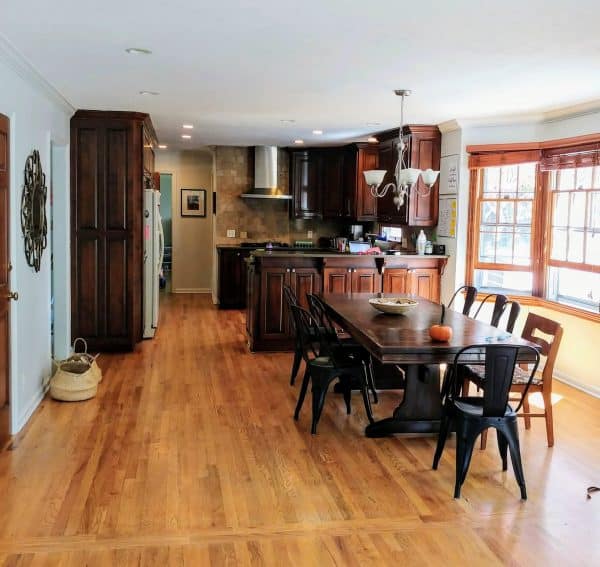
2. Tidy your entire house all at once and don’t stop until you’re done!
Kondo claims it’s impossible to truly adopt the life-long habit of tidying unless you do EVERYTHING at once. Go big or go home. Make a goal to get through every single item in your house in 6 months or less, depending on the size of your home and the depth of your piles of crap 😉
I actually agree with this!!! Especially after experiencing it myself in 2016, and then watching the show in early 2019.
If you pile ALL OF YOUR CLOTHES IN ONE BIG PILE ON YOUR BED, and sort through them one item at a time, you will probably never be in this situation again. Because from that moment on, you will have a way better picture of what you have, what you need, and what you love.
And you will have given yourself permission to purchase differently in the future.
I’m guessing your clothing budget (and your husband!) will thank you 😉
3. The only rule for keeping something – spark joy!
Does it “spark joy?” This is perhaps the phrase Kondo became most well known for… She has even came out with a book, Spark Joy, since my original writing of this post. (I didn’t get all the way through it.)
Kondo’s opinion is that all the arbitrary “rules” you hear from organizing professionals are well intentioned but ineffective. For example:
- get rid of one thing for everything you bring in the house
- throw out 10 things a day
- give away items you haven’t used in 6 months
She says they’re all mostly unsustainable and unsuccessful because you still bring home new stuff and haven’t changed any habits.
Instead, she says, pick up every single item in your house, one by one, and ask yourself, “does this bring me joy?” If yes, it stays. If no, it goes.
At first, I thought this was WHACKO.
My inner, sassy junior high girl came out and was all like, “Oh yeah, well what about diapers? Those don’t bring my joy but my kids poop, Kondo, so what do you have to say about that?”
She has an answer for that… appreciating the usefulness of an item, like a diaper, is another way of it bringing us joy. #Bam #Konmaried So, I bought in. I tried it.
I picked up each shirt and book and old photograph and asked myself: is this useful or do I love it? If not, I gave myself permission to toss it.
This process actually turned out to be much simpler than all other ‘rules,’ for whether or not to keep something. And it’s still my rule. Now, I basically throw out everything that is not useful or happiness-producing.
Oh, and Kondo says no I’m-sure-I’ll-use-this-someday pile allowed.
4. Permission to let go of sentimental items
This one was probably the biggest ‘ah ha’ for me. Marie says (we’re on a first name basis now…) that your possessions reflect your state of mind, and that we hold onto things for 1 of 2 emotional reasons – fear of the future, or to preserve the past. There were things in our house that felt in-the-way, or useless, but for some reason, I couldn’t let go of.
Mostly I realized they were things that had been given to us and I felt guilty getting rid of them. She gives “permission” to let them go after they’ve served their purpose. It’s truly the thought that counts. That person found joy in giving it to you, you had joy in receiving it, but now it’s no longer useful for you. So you can throw it out.
5. Declutter by category, not by room
While most organizing or whole-house-purging methods have you go room by room, Marie suggests going by category, in this order: clothes, books, papers, miscellaneous. For us, miscellaneous included:
- anything bathroom and toiletry related
- sewing & craft supplies
- linens and towels
- kitchen (dishes, accessories, food)
- office supplies
She has subcategories for each of those too. It seems her philosophy on this is 2 fold:
- You will be in shock when you see how much of one item you have – the shock helps give you permission to get rid of things you don’t love.
- It’s easier and more satisfying to cleanse out one whole category at a time. Then it all goes back in one place, rather than different places all over the house.
6. Everything alike sticks together
I’ve mostly done ‘flow based’ organizing, meaning, put stuff away where you use it. Marie says put everything that is alike together. So, all dishes together. All cleaning products go together. All clothing items together, including coats. All shoes together, rather than some by each door. She says this works better for 2 reasons:
- You will always know where something is. Rather than having to look in each closet and by each door for a specific pair of shoes, all your shoes will be in one spot.
- It’s easier to tidy and put things away. No more random clutter because everything has one place.
Mostly, we’ve abided by this in our home. Now that we live in a 3 story house, I do keep some things on each level… like extra toilet paper rolls.
But most things have one spot in our house. It DOES make tidying easier!
7. Throw everything out before putting anything back
Marie says, that when you’re done purging a particular category, you should first throw everything away that you’re going to get rid of.
Then, go put the stuff you’re keeping back.
8. Automatically change your habits
Kondo says that if you use her method, you will naturally change your habits. If you take the time and energy to sort through every single thing in your house, in every category, and choose whether or not to keep it base on whether or not it brings you joy, then you find only one place for each item… you will never go back.
The extreme epitome of “a place for everything and everything in it’s place.”
Two of the things from her method I DON’t do
1. The home-arrival charade
In the book, she explained her 5 minute routine when she gets home. She puts her shoes and coat in their appropriate places, completely empties her handbag, puts all those things in their places, thanks all her objects for doing their job, blah blah blah. It was obvious to me from this paragraph that she didn’t have kids at the time she wrote it.
I mean, maybe it’s just us, but we enter the house like a tornado: coats and shoes flung everywhere; mom and toddlers racing to the potty; everyone seems to always be starving and thirsty and crabby; and do you know how long it would take me to empty every single item out of my ‘handbag?’ Plus, what if I want those 3 month old cheerios at the bottom of my purse for a snack when I’m out tomorrow?
2. Her folding clothes method
Long story short – ain’t nobody got time for that.
She wants laundry to be relaxing- a family activity, perhaps?! Everyone thanking their clothes & appreciating them. Listen, I love that idea. It sounds magical. My whole family happily gathering to fold clothes & organizing them into perfectly kept drawers? That would be amazing.
But alas, I do a no-fold, no-sort laundry system and spend 1 hour a week TOTAL on laundry for our family of 6. My method is weird but it works and it’s FAST.
So, ya know, we didn’t Konmari EVERYTHING in our lives… haha
To KonMari or Not To KonMari?
All in all, I would say I’m a fan. I think it basically ‘worked.’ It was easy to get rid of that extra stuff I was saving out of guilt once I felt like I gave myself permission, realizing my relationship with people wasn’t based on gifts we’d given each other.
Overall, I am more careful about what I buy and bring home. I spend less time putting crap away in general.
On the other hand, we don’t all always put all our crap right where it goes right away. And sometimes we don’t clean anything for a whole weekend. As I write this, our entire house is actually a disaster. #KonMarieFail
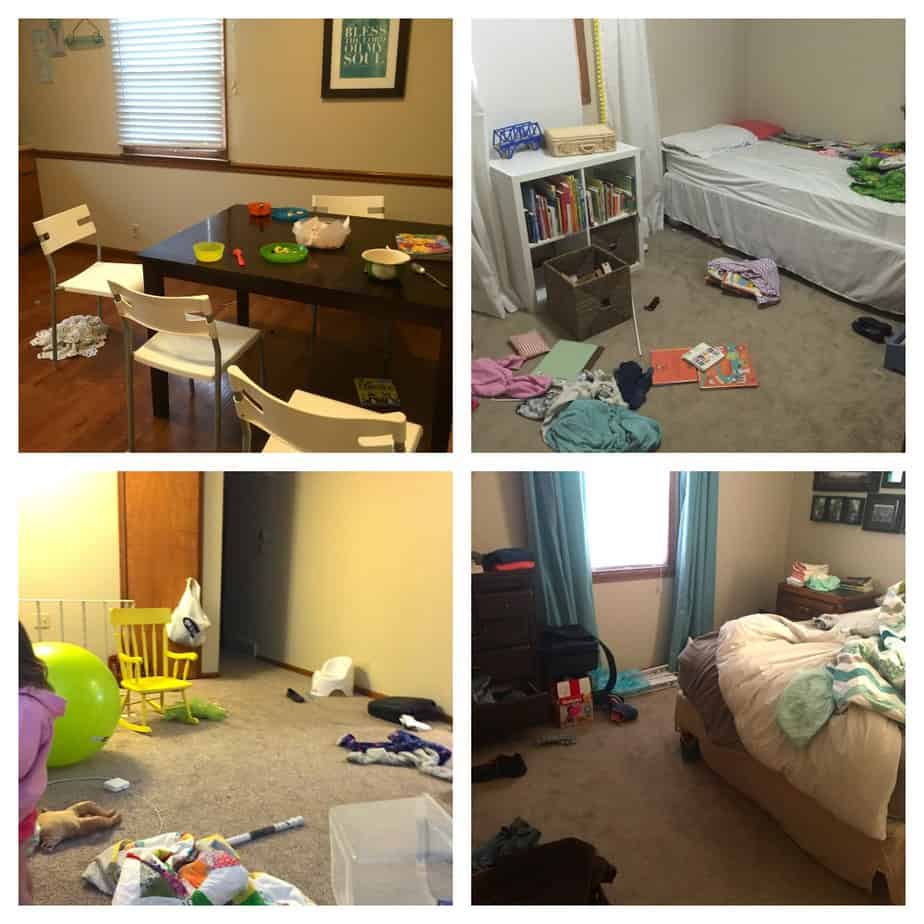
You can pin this. You’re welcome. Don’t tell Marie.
When I initially Konmari-ed everything, I was wrong about 2 things.
- I thought that things would feel empty. Like, I would throw stuff away and then want more to replace it. In fact, it was the opposite. I realized how much we had that we didn’t use or need. AND, I am way more careful about what I buy. Buying less means spending less.
- I thought our house would always be clean once I did this. Nope. It gets plenty messy all the time. (Ahem – see above pictures.) BUT, it’s messy on purpose. Because it’s being used. Meaning, it’s messy because my kids are playing with toys they like. Or because the dinner dishes are everywhere. Or because I was actually using the sewing stuff I kept around.
And sometimes because I just don’t feel like putting stuff away… don’t tell Marie 😉
Bottom Line: Does the Konmari Method Work?
The lady knows her stuff. Since it’s 2020, you can now go watch her Netflix documentary show and you will feel SUPER motivated to get tidying up with Marie Kondo!
Basically, although some of the book is weird, I like a lot of her ideas about how to get stuff truly organized “once and for all.” And if you feel tired of being surrounded by clutter, or never quite feel like you can have a system down, I definitely believe that she could basically help anyone get organized.
But, I differ with her on some things. Her emphasis on tidying doesn’t seem to leave much room for life. Life happens. Houses are for being used and they get messy and life goes on. You can always pick up your crap later.
So, have you read it? Or any of her other books? Or watched the show? Have you tried tidying up? Are you going to?
If so, don’t forget to grab my cheat sheet to help you stay focused! You can do it!! #DeclutterAllTheThings
[thrive_leads id=’9714′]

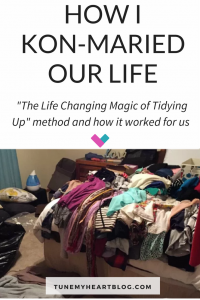
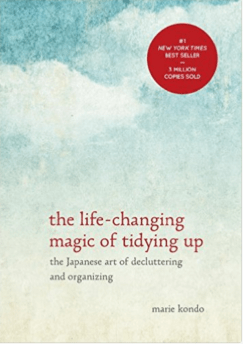
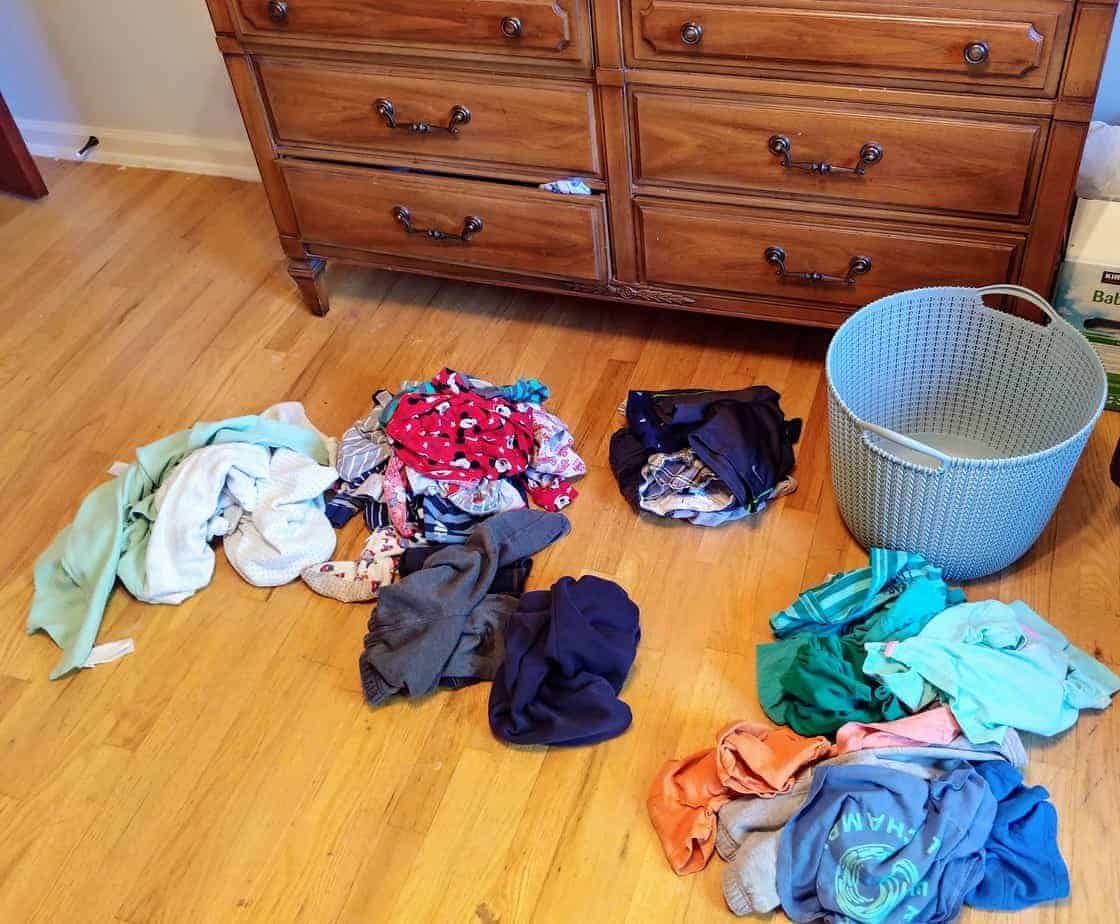
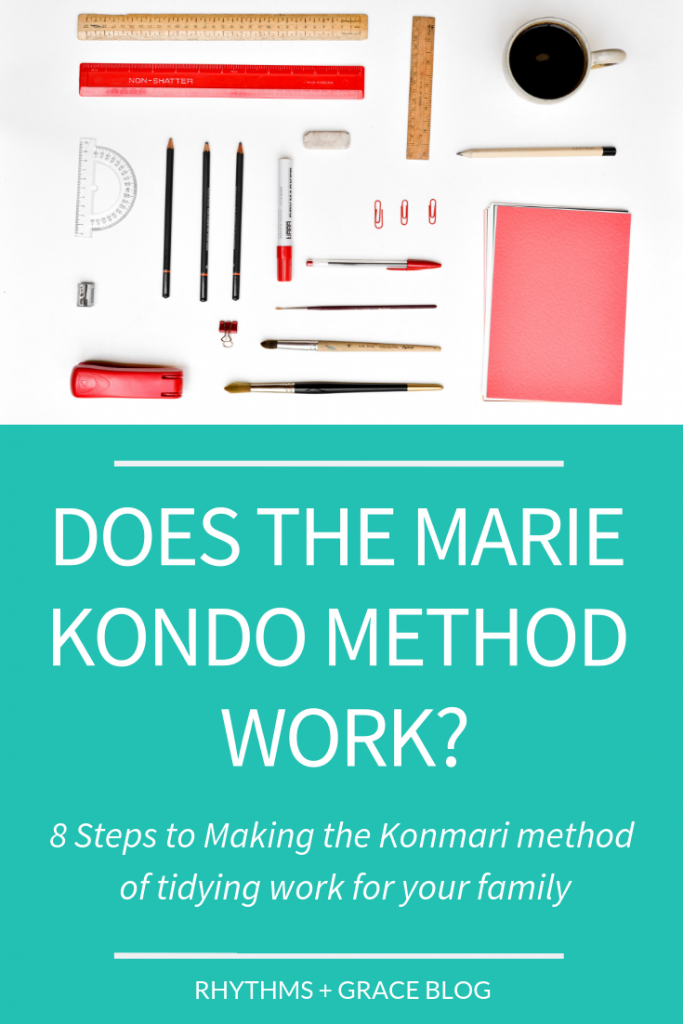
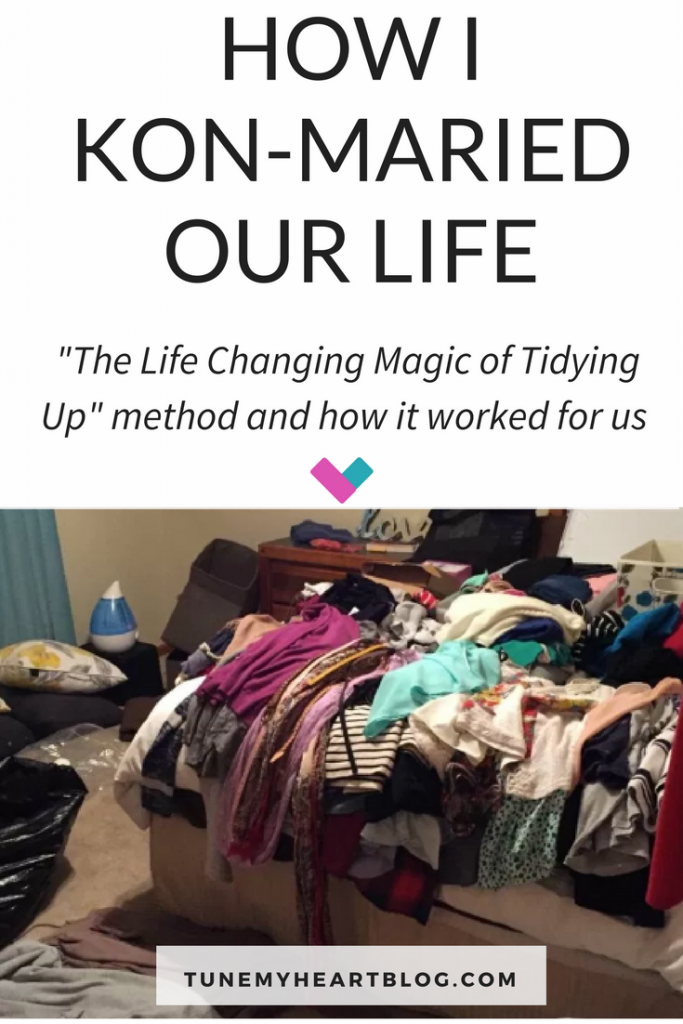
Agh! Crafts! I didn’t have a great way to decide. I just realized that I don’t craft that much. So I didn’t keep a bunch of random stuff. We don’t have a ton of storage space either. I could picture keeping more when we’re in a different season of parenting – where our kids are older and enjoy more unsupervised crafts. I did keep paints, paper, coloring stuff, etc. for the littles. Then I kept a few of my FAVORITE fabrics that I know I would use if I pulled out my sewing machine. I kept my sewing machine, thread, needles, etc. But basically got rid of everything else… and haven’t missed it! 🙂 If you’re a BIG crafter and love crafts, obviously that choice might look different for you, but I hadn’t used most of it in over a year (and probably won’t with soon-to-be- 4 kiddos under 6. haha!) If I ever get back into crafting, I can acquire favorite supplies at that point.
ok question! I haven’t read the book yet so maybe that will help (just ordered it on Amazon!) butyou said you had craft supplies. How did you decide what to keep? I have so many random little crafting objects for projects. I feel like I’d keep everything(but don’t really want to). What did you do?
Thanks for reading!! Glad it was helpful 🙂
I have been curious about the book also. I enjoyed your review. Your writing style is informative, and still light and fun!
Kondo would say – if it’s useful or brings you joy, you can keep it. i have a friend who loves vintage fashion. She loves thrift store shopping and finding new outfits. She has 2 closets full of clothes and wears something different every time, and regularly purges. I’m more of a minimalist wardrobe person. I want a few classic items and I wear them all the time. So, it totally depends on what you love! For your husband – it makes sense for him to have work clothes and regular clothes. For you (I’m also a SAHM), I would say, keep the ones that bring you joy and get rid of everything that doesn’t currently fit or you don’t love anymore. Then add slowly to your wardrobe from there. Kondo acknowledges that there’s no right number. If you love books, you’ll have more books than handbags, probably. If you love shoes, you’ll probably have more shoes, etc… make sense? 🙂
Ok so…. here’s the question for me: How many pairs of pants and shirts does one person need? I know for my husband who is a construction worker, he has a whole lot of work clothes. Then he has a separate wardrobe of regular clothes. I am a housewife, so nothing fancy really required for me. But I honestly don’t know what an appropriate number of shirts and pants are… 2 pair? 3 pair? is it normal to just own one pair of pants and a couple pair of shorts? …… aside from my weird question, I just want to say I like your article. I haven’t read the book yet, as there are 32 library copies and 46 ‘holds’ waiting. (I’m #47) But I can’t wait to read it. I loved hearing what you have to say and would probably agree with your differences of opinion. “Life happens”. … and that’s a good thing 🙂
thanks for reading! 🙂
You did a write-up on her book perfectly and I feel nearly exactly the same about what you think.
I like your life philosophy too – those babies stay little like a milisecond.
ooo that’s really helpful!!! i was actually just wondering about that 🙂 I’m 31 weeks pregnant with my 3rd. with a couple toddlers running around, a clean house is just not at the top of my priority list. so that’s encouraging 🙂 thanks!
I am currently konmari-ing my home. I’ve listened to her first book and partly through Spark Joy. In Spark Joy, she emphasizes not to assume you have rebounded just because your home is a little messy. You just haven’t put things back in their place and since they all have a home putting them back shouldn’t take very long (30-60 minutes). I find this helpful and a relief and hope you do too.
You cam also listen to the audiobook Free on Hoopla!
agree about having everything in one place. and less to choose from. so much easier 🙂
agree! that was my biggest takeaway too… and my husband and I have been jokingingly thanking our things ever since. haha!
Read her book and found the idea of letting things go that have served their purpose helpful. She was unintentionally humorous about speaking to your things and thanking them.
I just finished her book, and tackled my closet and clothing drawers, and feel sooooo much better every time I need to pick out something to wear. It’s a thousand times easier when everything in my closet is something I like. AND, I have enough room for winter/summer stuff in one place. I’m slowly working through the rest of the house…
ha! they need to konmari their library shelves! 🙂
I reserved a copy at the library too. Funny thing was the book was not checked out but they could not find it so suggested I reserve it so I could have it once they found it. Oh well, hopefully soon……
I too like organizing and decluttering, it centers me. I haven’t read the book yet but I went through all my clothes at the beginning of the year and donated a bunch of stuff and organized the remaining things using her method (found it on pinterest) and it has made a huge difference! Also, giving yourself permission to let go of things is a game changer.
Just reserved a copy at the library!